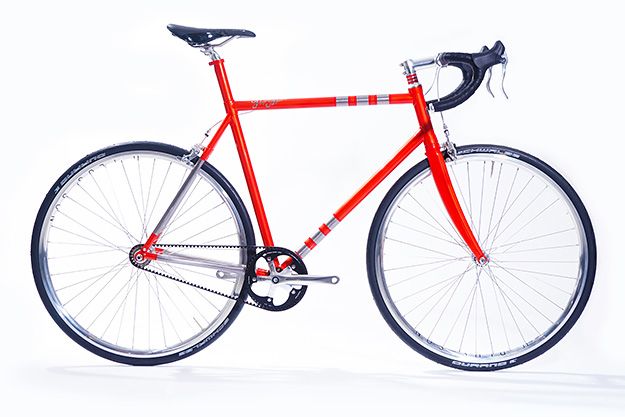Okay, so good and bad?
They used metal sintering to make the brackets. Sintered metal is NOT strong, so must be heat treated after forming to get any proper crystal growth and strength. That isn't mentioned so probably was not done.
The same technology could be used to make molds to cast the metal parts rather than sintering them and then heat treating them. This would be less work and likely stronger in the long term.
The titanium tubing is epoxied (glued) together into the brackets for good reason, despite the complaints in the comments. Somewhat forgivable ignorance on their part, but the designers knew better. If you heat up Titanium above 600'C to weld it, it absorbs oxygen like a sponge and turns into a white powder used to make white paint and cosmetics. This powder is its most common form. To avoid this, you have to immerse it in argon and drive out the oxygen, then weld it inside a 6-8 foot diameter plexiglass dome using gloves and sleeves from the outside. A leak ruins the project. Titanium is a PITA to work with for this reason. Gluing titanium together avoids the issue and really is the best option. However, the epoxy durability over time is likely limited and will eventually fail, unlike a weld, leading to the bike cracking at the worst time and place. Not a good thing.
Carbon fiber has the same problem with epoxy, but it is easier to work with than Titanium, which is why Carbon Fiber frames are more common. They're also quite a lot cheaper. They do require vacuum molds, something else this technology could do.
They made the components on the bike themselves, thus the single speed. No derailleurs, and that stupid belt which lacks any visible centering mechanism I can see, so its going to fall off.
How would I do this better? Off the shelf components. Aluminum TIG welded frame, heat treated for strength. Fit and finish work done by people who care about craftsmanship. Build a carbon fiber version the following year.
Apply what is learned to moped design using same techniques, using aluminum for one model, steel frame for another, and carbon fiber for a third. Test for strength with road-test models and weekly checks for damage. Figure out the proper wheel size and suspension requirements, using what is learned from Mountain Bikes and Underbone scooters. Make the best options production models after at least one year of testing. Retain 4-bolt engine swap design, and offer the bash plate as standard. (bash plate is a piece of thick aluminum under the engine which protects the engine from hitting stuff the front wheel goes over in off-road conditions.
Build Underbone transmission case which allows mounting TWO mechanically synchronized engines on either side, similar to a BMW opposed engine, going to the single drive output. Allow mounting from 70cc to 200cc engines, and rate parts for that amount of torque stress.
Build ultralight towncar/golfcart to use this transmission, including electric reverse gear which also doubles as regenerative braking system to ultracapacitor for extra power that trickle charges into Lithium Phosphate battery option. Car should be very light, leaning or mini-truck type slow vehicle, not made for highway use, just in-town deliveries or farm use. These will eventually be the dominant vehicle for poor people someday as they are cheap to build, use little fuel, and are better than nothing.
Considering that Chrysler is now Fiat and its headquarters have moved to The Netherlands, it is no longer remotely an American car company. There is no Big 3 anymore. It is Ford and GM, and most of their business is done overseas. We are left with its former employees either fixing things wrong with the production models using the aftermarket parts they were forbidden to produce under contract or entirely new designs they weren't allowed to make because it would embarrass their flagship models by revealing the flaws Executive's careers depended on ignoring their responsibility for causing. With their collapse, we have freedom to be creative. Particularly with the huge market for kit cars. And reskinning a crappy hatchback around a race-tube or aluminum tub frame bolted to the crucial registration numbers avoids the crash test nonsense. Just carry the book with the pictures for when you get stopped by the Highway Patrol.
This is a reasonable direction to take your bicycle building, if you're any good at it. Or can you can stop and rest on your laurels at any step of the way and stop innovating. In the real world, building cars from 3D printing at various scales is the ultimate outcome of the technology. Building 3D printers too. They are sort of Von Neumann probes, after all. When they get good and fast enough, we won't even need to import from China anymore. Their factories will be irrelevant. How d'ya like d'em apples?

No comments:
Post a Comment